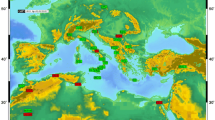Abstract
A target of our study was the Bohemian Massif in Central Europe that was emplaced during the Variscan orogeny. We used teleseismic records from ten broadband stations lying within and around the massif. Different techniques of receiver function interpretation were applied, including 1-D inversion of R- and Q-components, forward modelling of V s velocity, and simultaneous determination of Moho depth and Poisson’s ratio in the crust. These results provide new, independent information about the distribution of S wave velocity down to about 60 km depth. In the area of Bohemian Massif, the crustal thickness varies from 29 km in the NW to 40 km in the SE. A relatively simple velocity structure with gradually increasing velocities in the crust and uppermost mantle is observed in the eastern part of the Bohemian Massif. The western part of the massif is characterized by more complicated structure with low S wave velocities in the upper crust, as well as in the uppermost mantle. This could be related to tectono-magmatic activity in the Eger rift that started in the uppermost Cretaceous and was active in the West Bohemia-Vogland area till the late Cenozoic.
Similar content being viewed by others
Author information
Authors and Affiliations
Rights and permissions
About this article
Cite this article
Wilde-Piórko, M., Saul, J. & Grad, M. Differences in the Crustal and Uppermost Mantle Structure of the Bohemian Massif from Teleseismic Receiver Functions. Stud Geophys Geod 49, 85–107 (2005). https://doi.org/10.1007/s11200-005-1627-3
Published:
Issue Date:
DOI: https://doi.org/10.1007/s11200-005-1627-3




